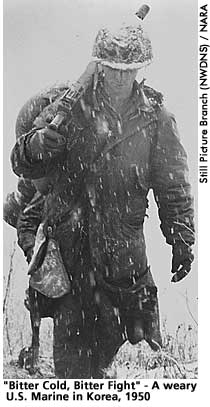Anti-American Sentiment in South Korea
By BonnieBlueFlag

The Korean War cost 54,000 American lives.
On June 25, 1950, North Korean troops suddenly invaded South Korea, and they reached Seoul in the first weeks of July.
The United States had not maintained a contingent of troops in South Korea after World War II; so the North Koreans supported and outfitted by the Soviet Union, had very little difficulty in advancing on Seoul.
The Chairman/Leader of North Korea, Kim Il Sung, had convinced Josef Stalin that an invasion of South Korea would be welcomed, and that the South Koreans would overthrow their own government, which they did not.
On September 15, 1950, General Douglas MacArthur leading American and UN troops landed at Inchon, a seaport in the city of Seoul, and they were eventually able to force the withdrawal of the North Koreans.
It would not be until July of 1953 that an armistice was signed, however, no peace treaty was ever signed.
In 1957 only four years after the signing of the armistice, grateful South Koreans erected a 15 foot tall bronze statue of General Douglas MacArthur.
Today, a little over 50 years later, this is the scene near the statue of Gen. MacArthur.

South Korean riot police officers stand guard near a statue of U.S. Gen. Douglas MacArthur during a demonstration at a war memorial housing a statue of U.S. Gen. Douglas MacArthur in Inchon, west of Seoul, Sunday, July 17, 2005. Anti-MacArthur demonstrators marching at Freedom Park were met by thousands of his supporters who pelted them with objects and shouted invective. Half a century after MacArthur landed behind North Korean lines and led U.N. forces in a counterattack that turned the tide of the Korean War, South Koreans still argue over whether his memory should be revered or banished from the peninsula. (AP Photo/Lee Jin-man)
In 2004, prior to the November presidential election, the Pentagon announced that 3,700 American troops would be withdrawn from South Korea and deployed in Iraq, and that remaining troops would be repositioned in a more southerly location, with 12,500 of those to be stationed elsewhere.
Presidential candidate, John Kerry felt that this was a display of cowardice by the Bush administration. The South Koreans were concerned that our troops were leaving the DMZ, and alarmed that they could be potentially leaving all together. While Chairman Kim Jong Il (son of Kim Il Sung), and the North Koreans, believed that the repositioning of troops was to put them out of missile range, and saw this as a first step in our preparation to attack North Korea.
So military actions taken by the Bush administration, were anything but a show of cowardice, as proclaimed by John Kerry.
Today the students and young people of South Korea, have no memory of the violence visited upon their parents and grandparents by Kim Jong Il's father. Nor do they realize that the unification of Korea under Kim Jong Il's terms would destroy their way of life. They have elected an anti-American government in President Roh Moo Hyun, and are eager to see the Americans leave South Korea.
Kim Jong Il's own people have been reduced to eating grass and acorns, but the young South Koreans do not see how he might covet the economic wealth of the agricultural South.

South Korean students carry an effigy of U.S. President George W. Bush and the Statue of Liberty during an anti-war rally in downtown Seoul. About 500 students demanded withdrawal of U.S. troops from South Korea.(AP Photo/Ahn Young-joon) (July 23, 2005)
Will this be a case of, "Those who do not remember history, will be condemned to repeat it?" Unfortunately, those of us who do remember, will be forced to relive it as well.
Written by: BonnieBlueFlag


1 Comments:
Those little (racial epithets) had better learn some respect.
If it hadn't been for the blood and treasure of United Statesians, those little (racial epithets) would be speaking Korean today.
And not only would they not be selling any Hyundais over here, they'd be starving like the slaves in North Korea.
Kelly Sullivan
Post a Comment
<< Home